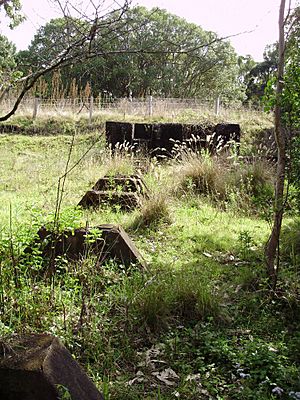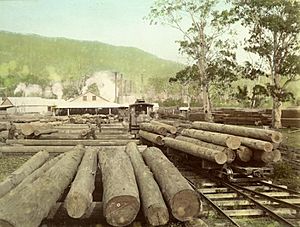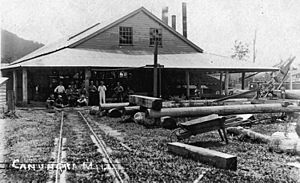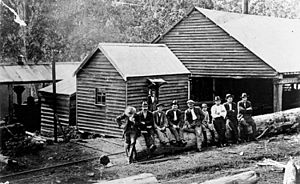Lahey's Canungra Sawmill facts for kids
Quick facts for kids Lahey's Canungra Sawmill |
|
|---|---|

Machinery foundations at Lahey's Canungra Sawmill, 2008
|
|
| Location | 10-26 Finch Road, Canungra, Scenic Rim Region, Queensland, Australia |
| Design period | 1870s - 1890s (late 19th century) |
| Built | 1884 |
| Official name: Lahey's Canungra Sawmill Complex | |
| Type | archaeological |
| Designated | 6 March 2009 |
| Reference no. | 645602 |
| Significant period | 1884 - c.1935-9 |
| Significant components | brick scatter/deposit, metal scatter/deposit, building foundations/ruins |
| Lua error in Module:Location_map at line 420: attempt to index field 'wikibase' (a nil value). | |
Lahey's Canungra Sawmill was a very important place in Canungra, Australia. It was a large sawmill that cut down trees into timber. The mill started in 1884 and was a big part of the area's history. Today, only its old foundations and other remains are left. This site is now protected as a heritage-listed place.
Contents
A Look Back at Lahey's Sawmill
The Canungra Sawmill was open from 1884 until about 1935. For many years, the Lahey family owned and ran the mill. They brought timber from forests around Canungra to the mill. They used their own private tramway for this. Once cut, the timber was sent out of Canungra on the government railway.
How the Sawmill Started
The Lahey family came to Australia from Ireland in 1862. They first started farming near Pimpama in 1870. Later, they bought a sugar mill and added sawmilling to their business. This became a major part of their family's work.
David Lahey heard about good timber in the Canungra area. So, he started building the sawmill in Canungra on October 2, 1884. The Lahey family also bought a lot of land around Canungra. They built small houses for the mill workers nearby.
The sawmill's machinery was brought by boat up the Logan River. Then, bullock teams, which are groups of oxen, pulled the heavy parts to the mill site. The mill started making more and more timber from 1885 onwards. Much of this timber was used to build houses across southeast Queensland.
Growing the Business
The Lahey family was very hard-working and always looked for new ideas. They wanted to keep up with what people needed. In the 1880s, they made their business bigger. They opened an office in Brisbane in 1887. They also built more sawmills in other towns like Beaudesert.
During tough economic times in the 1890s, the Laheys found new ways to make money. They started making "staves." These are narrow pieces of wood used to build barrels or other containers. This helped them keep their business going.
Fires and New Ideas
On July 9, 1897, the Canungra mill burned down. A lot of cut timber was also destroyed. But the Laheys rebuilt the mill even bigger and better. They made it more modern and separated some of the machines.
The mill was badly damaged by fire again on January 13, 1906. The main building where the sawing happened was completely destroyed. New machines from the United States were lost. However, a new drying kiln and a planning machine shed were saved. The mill had to close for three months after this fire.
Moving Timber: The Tramway
By the early 1900s, getting timber to the mill was a challenge. The Laheys had bought a lot of forest land. This meant bullock teams had to pull logs over longer and longer distances. The Laheys decided to build a tramway to make transport easier.
They chose a narrow track size for the tramway. This was the same size as the government railway lines. They hoped the government railway would eventually reach Canungra, which it did in 1914. The tramway grew over time, reaching about 26.5 kilometers (16 miles) long. It helped bring huge amounts of logs to the mill.
The Mill's Biggest Years
In 1913, Tom Lahey traveled to the United States. He wanted to see the latest sawmilling methods and buy new machines. When the new equipment was installed, the mill could cut twice as much timber. It also needed fewer workers.
With new machines, Lahey's Canungra Sawmill became the biggest softwood mill in Queensland. It even produced the most softwood timber in all of Australia. Because of the mill's success, the town of Canungra grew around it.
Changes and Closure
By 1920, most of the good timber in the Canungra area had been cut. After World War One, a group called the War Services Homes Commission bought the mill from the Lahey family. They planned to use the timber to build homes for soldiers returning from the war.
However, the mill closed just three months later due to a change in plans. In 1923, Brisbane Timbers Ltd bought the mill. This company was partly owned by the Lahey family. The sale included all the machinery, land, and the timber tramway. In 1933, another company bought the mill and added a special plant to make veneer and plywood.
But the timber industry in Canungra was slowing down. Around 1935, the mill finally closed for good. The tramway tracks and equipment were sold off. The mill was then taken apart.
What's Left Today?
Today, the old sawmill site is an empty field in Canungra. You can still see the archaeological remains of the mill. These are like clues from the past, showing where the buildings and machines once stood.
Finding Old Foundations
In the middle of the field, you can find many concrete foundations. These were the bases for the mill's steam engine and other machines. There's a large concrete slab that might have been for a crane. This crane would have lifted logs from the trams.
You can also see the ends of old tramway rails stuck in a concrete foundation. Broken bricks are scattered around, some from old brickworks in Brisbane. There are also a few metal pieces left. Experts believe there might be many more hidden items underground. These could tell us even more about the mill.
Another group of foundations is in the northern part of the field. These are near where the old railway line used to be. They might have been used to load timber onto trains. They could also be from the later veneer and plywood factory.
Why This Place is Special
Lahey's Canungra Sawmill was added to the Queensland Heritage Register on March 6, 2009. This means it's an important historical site.
A Piece of History
The sawmill site helps us understand Queensland's history. It shows how important the timber industry was from 1884 to 1921, and again from 1933 to 1935. It also shows how towns like Canungra grew because of industries like this. When it was at its busiest, the mill was the biggest softwood mill in Queensland and Australia.
Learning from the Past
Studying the remains of Lahey's Canungra Sawmill can teach us a lot. We can learn about how timber was processed long ago. We can also learn about the Lahey family, who were very important in Queensland's history. The site can also tell us about the daily lives of the workers in the late 1800s and early 1900s.
By looking at the old foundations and hidden items, we can understand how the mill was laid out. We can also see how the ways of working changed over time. The Lahey family was known for trying new things. So, digging here might show us new details about how they made timber.
Finding more items at the site, especially where the main mill was, can help us learn even more. It helps us understand the Lahey timber business in Canungra. It also gives us information to compare with other old sawmill sites across Queensland.
By studying what's left underground, we can learn about the working conditions and daily life at the mill. We might even find things related to the first houses built for the mill workers. This site helps us answer many questions about early timber processing, life at an old mill, and the impact of the Lahey family on the timber industry in Queensland.




